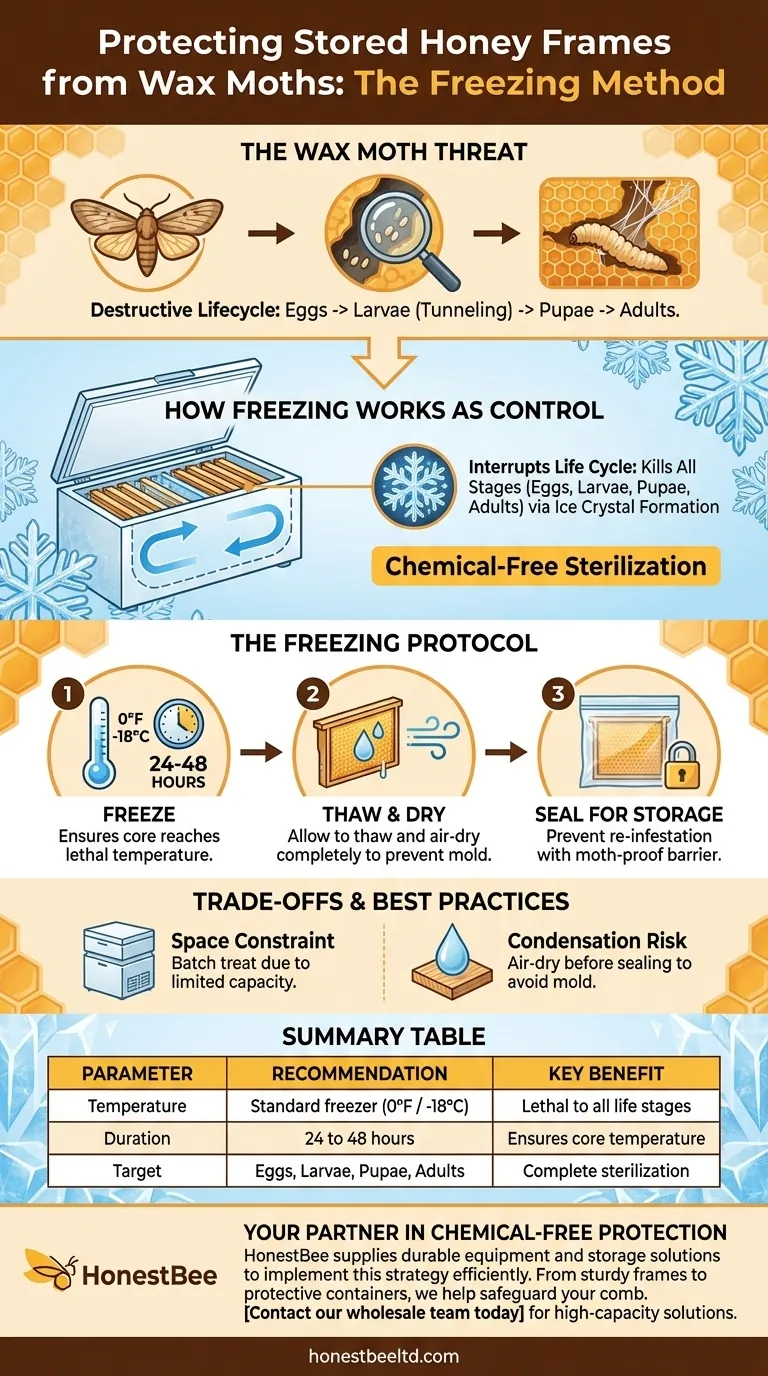Freezing is an effective method to protect stored honey frames by killing the entire life cycle of the wax moth—eggs, larvae, pupae, and adults. Exposing the frames to freezing temperatures for a sufficient duration ensures that any existing infestation is completely eradicated, preventing the destructive larvae from tunneling through and destroying the comb during storage.
The core challenge isn't just killing adult moths; it's about eliminating the nearly invisible eggs and larvae already present in the comb. Freezing provides a definitive, chemical-free way to sterilize the frames before you store them, ensuring they remain viable for the next season.

Why Wax Moths Are a Threat to Stored Comb
The Destructive Lifecycle
Wax moths are a persistent pest for beekeepers. The adult moths themselves do not cause damage, but they lay their eggs in the dark, protected spaces within a hive or, more commonly, in stored beekeeping equipment.
When these eggs hatch, the larvae begin to consume beeswax, pollen, and honey remnants. They create a network of silk-lined tunnels throughout the comb, destroying its structure and rendering it useless for the bees.
The Problem with Stored Frames
Frames that have been removed from the hive, especially brood frames containing pollen and old cocoons, are prime targets. The scent of old comb is a powerful attractant for female moths looking to lay eggs. Without the constant vigilance of a healthy honey bee colony to remove them, a small number of eggs can lead to a devastating infestation in a matter of weeks.
How Freezing Works as a Control Method
Interrupting the Life Cycle
Freezing is a physical control method that works by killing the pests at every stage. The formation of ice crystals within their cells destroys the moths, larvae, and, most importantly, the eggs.
This is a critical advantage over methods that only target adult moths, as it ensures no new larvae can hatch and begin their destructive work while the frames are in storage.
Required Duration and Temperature
To be effective, the frames must reach a temperature that is lethal to the pests and be held there long enough to ensure none survive. While the exact temperature can vary, a standard home chest freezer is more than adequate.
A minimum of 24 to 48 hours at freezing temperatures is the widely accepted standard. This duration ensures that the core of the frames, which are insulated by wood and wax, reaches and maintains the lethal temperature long enough to kill all life stages.
Understanding the Trade-offs and Best Practices
The Space Constraint
The most significant limitation of freezing is the physical space required. Most beekeepers use a chest freezer, but this can only hold a limited number of frames at once. For those with many hives, this means treating frames in batches, which can be a time-consuming process.
Preventing Re-infestation
Freezing sterilizes the frames, but it does not make them immune to future infestations. Once removed from the freezer, the frames must be stored in a moth-proof manner.
This typically involves placing the treated frames in heavy-duty plastic bags or sealed containers. The goal is to create a physical barrier that prevents adult moths from accessing the comb to lay new eggs.
Risk of Condensation
When you remove frozen frames and bring them into a warmer, more humid environment, condensation can form. This moisture can potentially lead to mold growth if the frames are sealed up before they are completely dry.
To mitigate this, allow the frames to thaw and air-dry completely in a protected, well-ventilated area before sealing them for long-term storage.
Applying This to Your Storage Strategy
- If you have a small number of hives: A dedicated chest freezer is an excellent and highly effective investment for rotating and treating all your frames post-harvest.
- If you have a large apiary: You may need to combine freezing for your best combs with other methods, like stacked storage in a well-ventilated area, for the remaining frames.
- If you are prioritizing chemical-free beekeeping: Freezing is the definitive non-chemical solution for ensuring your stored comb is completely clear of wax moth pests.
By integrating a proper freezing and storage protocol, you can reliably protect your valuable drawn comb from wax moth destruction.
Summary Table:
| Freezing Parameter | Recommendation | Key Benefit |
|---|---|---|
| Temperature | Standard freezer temperature (0°F / -18°C) | Lethal to all life stages |
| Duration | 24 to 48 hours | Ensures core of frames reaches lethal temperature |
| Target | Eggs, Larvae, Pupae, Adult Moths | Complete sterilization of frames |
Protect your investment with the right equipment.
Freezing is a cornerstone of an effective wax moth management plan. For commercial apiaries and distributors, having reliable, high-capacity storage solutions is key to scaling this method.
HONESTBEE supplies the durable beekeeping equipment and storage supplies you need to implement this chemical-free strategy efficiently. From sturdy frames to protective storage containers, we help you safeguard your comb.
Contact our wholesale team today to discuss equipment solutions for your operation.
Visual Guide

Related Products
- Gourd Shaped Hanging Wasp Trap Professional Wasp Catcher
- Professional Bucket Style Wasp and Moth Pheromone Trap
- Black Plastic Beetle Barn Hive Beetle Trap for Beehives
- Professional Galvanized Hive Strap with Secure Locking Buckle for Beekeeping
- Professional Grade Foldable Beehive Handles
People Also Ask
- How do beetle traps like Beetle Blasters support bee colonies? Protect Your Hives from Destructive Pests
- How do Beetle Blasters trap adult beetles? A Simple, Non-Chemical Pest Control Solution
- Is it normal to see small hive beetles in a hive? Spotting the Difference Between a Pest and a Problem
- What are the signs of a severe small hive beetle infestation? Prevent Hive Collapse and Protect Your Investment
- What precautions should be taken when handling beetle traps? Safeguard Your Hive from Accidental Harm



















